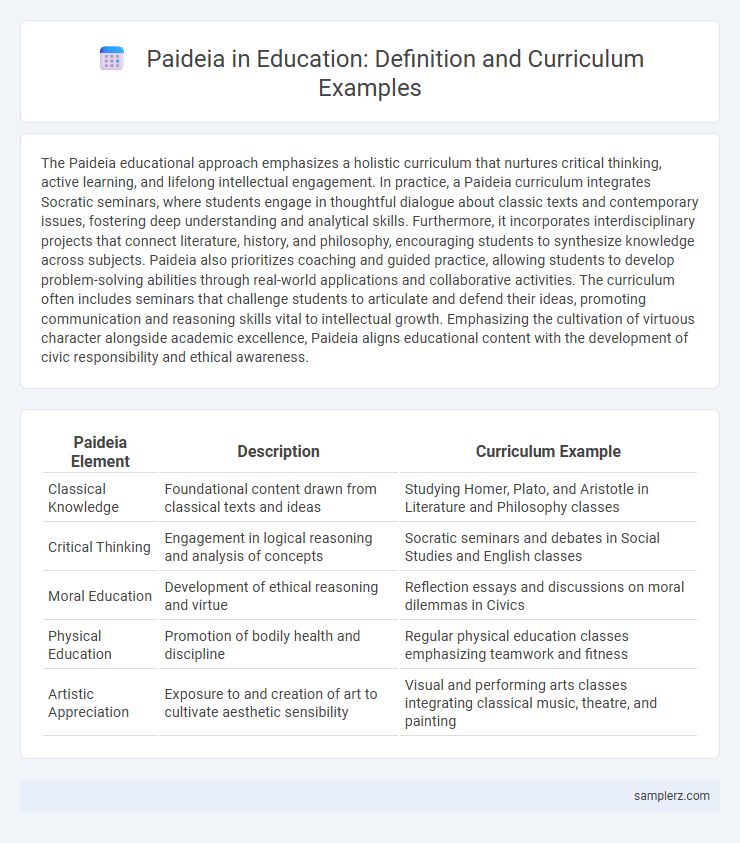The Paideia educational approach emphasizes a holistic curriculum that nurtures critical thinking, active learning, and lifelong intellectual engagement. In practice, a Paideia curriculum integrates Socratic seminars, where students engage in thoughtful dialogue about classic texts and contemporary issues, fostering deep understanding and analytical skills. Furthermore, it incorporates interdisciplinary projects that connect literature, history, and philosophy, encouraging students to synthesize knowledge across subjects. Paideia also prioritizes coaching and guided practice, allowing students to develop problem-solving abilities through real-world applications and collaborative activities. The curriculum often includes seminars that challenge students to articulate and defend their ideas, promoting communication and reasoning skills vital to intellectual growth. Emphasizing the cultivation of virtuous character alongside academic excellence, Paideia aligns educational content with the development of civic responsibility and ethical awareness.
Table of Comparison
| Paideia Element | Description | Curriculum Example |
|---|---|---|
| Classical Knowledge | Foundational content drawn from classical texts and ideas | Studying Homer, Plato, and Aristotle in Literature and Philosophy classes |
| Critical Thinking | Engagement in logical reasoning and analysis of concepts | Socratic seminars and debates in Social Studies and English classes |
| Moral Education | Development of ethical reasoning and virtue | Reflection essays and discussions on moral dilemmas in Civics |
| Physical Education | Promotion of bodily health and discipline | Regular physical education classes emphasizing teamwork and fitness |
| Artistic Appreciation | Exposure to and creation of art to cultivate aesthetic sensibility | Visual and performing arts classes integrating classical music, theatre, and painting |
Understanding Paideia: Foundations in Education
Paideia in curriculum emphasizes holistic education, integrating critical thinking, dialogue, and ethical reasoning to develop well-rounded individuals. The Socratic seminar and seminar method serve as prime examples, fostering active student engagement and reflective learning. This approach aligns with classical education principles, promoting intellectual and moral growth through interdisciplinary study.
Historical Roots of Paideia in Curriculum Design
The historical roots of Paideia in curriculum design trace back to ancient Greek education, where holistic development aimed at cultivating virtue, critical thinking, and civic responsibility. Paideia emphasizes a liberal arts education, integrating grammar, logic, and rhetoric to develop intellectual and moral faculties. This classical model influenced Renaissance humanism and modern educational philosophies that prioritize well-rounded knowledge and dialectical teaching methods.
Key Principles of the Paideia Approach
The Paideia Approach centers on three key principles: active learning through Socratic seminars, the integration of critical thinking skills across disciplines, and fostering intellectual habits such as inquiry, dialogue, and reflection. This method emphasizes a curriculum that balances didactic instruction, coaching, and seminar discussion to develop well-rounded, lifelong learners. Schools implementing Paideia often incorporate interdisciplinary texts and project-based assessments to cultivate deeper understanding and intellectual rigor.
Integrating Paideia into Modern Classrooms
Integrating Paideia into modern classrooms emphasizes critical thinking, active dialogue, and interdisciplinary learning based on classical education principles. Teachers implement Socratic seminars and cooperative projects that encourage students to analyze texts deeply and articulate ideas clearly. This approach cultivates intellectual rigor and civic responsibility, aligning with contemporary educational goals of holistic student development.
Paideia Seminars: Fostering Critical Thinking
Paideia Seminars exemplify the application of the Paideia approach by promoting critical thinking through structured dialogue and Socratic questioning. This method encourages students to engage deeply with complex texts, analyze diverse perspectives, and develop reasoned arguments. Integrating Paideia Seminars into the curriculum enhances analytical skills, active listening, and collaborative learning essential for academic success.
Core Curriculum Subjects with Paideia Examples
Core curriculum subjects such as literature, history, and mathematics integrate Paideia principles to foster critical thinking and intellectual virtues. In literature, Socratic seminars encourage deep dialogue and interpretative analysis, promoting lifelong learning habits. History classes utilize primary source evaluations to develop reasoning skills and ethical understanding, while mathematics emphasizes problem-solving and logical inquiry aligned with Paideia's educational ideals.
Teacher Roles in a Paideia-Based Curriculum
In a Paideia-based curriculum, teachers act as facilitators who guide critical thinking and Socratic dialogue rather than simply delivering content. They design open-ended questions and create collaborative learning environments that cultivate active student participation and intellectual inquiry. This approach positions teachers as coaches who nurture students' abilities to analyze, synthesize, and apply knowledge across disciplines.
Student Outcomes from Paideia Implementation
Paideia implementation in curriculum fosters critical thinking, effective communication, and lifelong learning skills among students. Emphasizing Socratic seminars and interdisciplinary projects enhances intellectual engagement and collaborative problem-solving capabilities. The result is students who demonstrate increased analytical abilities, ethical reasoning, and a deeper understanding of democratic values.
Challenges and Solutions in Paideia Adoption
Paideia adoption faces challenges such as resistance to change among educators, limited resources for professional development, and difficulty in aligning traditional curricula with Socratic seminar methodologies. Solutions include comprehensive teacher training programs, incremental integration strategies, and collaborative curriculum design involving stakeholders to ensure relevance and engagement. Effective implementation enhances critical thinking and holistic education aligned with classical Greek ideals.
Case Studies: Schools Succeeding with Paideia
Schools integrating the Paideia curriculum emphasize Socratic seminars and interdisciplinary projects to foster critical thinking and holistic learning. Case studies of institutions like St. Mary's Academy demonstrate significant improvements in student engagement and academic performance through Paideia's emphasis on active dialogue and integrative inquiry. Data from these schools highlight enhanced reasoning skills and deeper content mastery, validating Paideia's role in transforming contemporary education models.

example of paideia in curriculum Infographic
 samplerz.com
samplerz.com